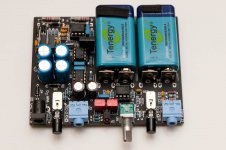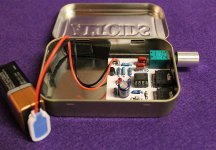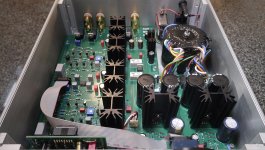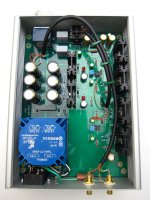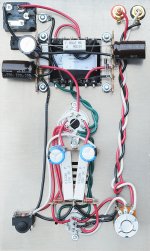Yes thanks, I realized I missed the GB - but am in no hurry (already have too many headamps), but I cannot stop this urge to build. 🙂
Would be great if the diyAudio Store can sell them - they can do with more headamp options. In fact, I think many great builds gets missed, lost or forgotten in the GB thread - many more should/could be sold by the Store.
Would be great if the diyAudio Store can sell them - they can do with more headamp options. In fact, I think many great builds gets missed, lost or forgotten in the GB thread - many more should/could be sold by the Store.
Last edited:
I sent an email to the DIYSTORE, asking them to stock and sell these boards. They responded very positively!
So send them a note also!
Alex
So send them a note also!
Alex
Elsewhere on this site I've seen a headphone amp powered by a much more convoluted arrangement: AC mains --> wall wart giving X volts DC output --> DC to DC converter giving X+10 volts DC output --> capacitance multiplier / linear voltage regulator X volts DC output --> headphone amp. Really? Yes, really.
One of mine goes AC->Wall wart->CLC->DC:2DC converter->CLC->LDO->CCS->CRCRC->Amp.......
It is dead silent though....
By the way, parts ordered for the T2 build.. 🙂
So I thought I had kind of matched the 68 ohm resistors, but this morning I took a closer look at the schematic and realized that they are in pairs, I thought 4 were in parallel because I didn't pay enough attention :/
The anal part of me wants to fix it so they are better matched, really should have bought extra resistors to get a better match, but I didn't.
Guess if I worry about matching, the pair to pair matching for one channel is more important than channel to channel matching?
Other thing I could do is add a larger value resistor to the pairs with higher resistance, to lower them enough to get closer matches.
Randy
The anal part of me wants to fix it so they are better matched, really should have bought extra resistors to get a better match, but I didn't.
Guess if I worry about matching, the pair to pair matching for one channel is more important than channel to channel matching?
Other thing I could do is add a larger value resistor to the pairs with higher resistance, to lower them enough to get closer matches.
Randy
If you open the "Tweaks, Optimizations, and Silly Changes" pdf file in Acrobat Reader, and if you search for the word stem "match" you will discover that it is never used, not even once. No "match", no "matching", no "matched", nothing.
Matching is not discussed at all. Don't take my word for it, have a look yourself.
You won't find "matched" but you will find, at the end of the first paragraph, some good advice.
Matching is not discussed at all. Don't take my word for it, have a look yourself.
You won't find "matched" but you will find, at the end of the first paragraph, some good advice.
If you open the "Tweaks, Optimizations, and Silly Changes" pdf file in Acrobat Reader, and if you search for the word stem "match" you will discover that it is never used, not even once. No "match", no "matching", no "matched", nothing.
Matching is not discussed at all. Don't take my word for it, have a look yourself.
You won't find "matched" but you will find, at the end of the first paragraph, some good advice.
If I offended you, I'm sorry, it wasn't the intent.
Thanks again for the boards.
Randy
One of mine goes AC->Wall wart->CLC->DC:2DC converter->CLC->LDO->CCS->CRCRC->Amp.......
It is dead silent though....
By the way, parts ordered for the T2 build.. 🙂
Was this the amp? 🙂
I seem to recall it has a smooth like a baby's bottom noise floor:
That amp looks way more complex than the T2 is IMO...many boards and parts. Having a less complex design that works so great is a super plus. Especially for newbies etc...and folks like me that have been building and using more complex designs for years. For me is once again proves simple can be excellent.
Alex
Alex
There's plenty of room in the playpen for everybody. Different size boxes, different amounts of innards in the box, different attitudes towards tubes / ICs / discretes / SMD, different sets of features included / omitted, the list goes on forever.
Here are just a few examples that people have built and enjoyed: the Objective-2, CMOY, Pass HPA-1, Neurochrome, Whammy, Bottlehead Crack.
_
Here are just a few examples that people have built and enjoyed: the Objective-2, CMOY, Pass HPA-1, Neurochrome, Whammy, Bottlehead Crack.
_
Attachments
Last edited:
That amp looks way more complex than the T2 is IMO...many boards and parts. Having a less complex design that works so great is a super plus. Especially for newbies etc...and folks like me that have been building and using more complex designs for years. For me is once again proves simple can be excellent.
Alex
I agree it's complex - not a project for the beginner, no worse than a Whammy or Neurochrome, but I have had a https://www.diyaudio.com/forums/group-buys/322638-xrk971-desktop-class-dca-headphone-amp.htmlhttps://www.diyaudio.com/forums/group-buys/322638-xrk971-desktop-class-dca-headphone-amp.htmltwo-transistor SE Class A headphone amp, and also here, out for a while now. Includes on-board cap multiplier for the power supply. Here is DrPro's excellent implementation. One can also use an external 24v Class 2 linear wallwart if desired.
Last edited:
xrk971,
Thats a very nice layoyut. I am tempted to try it!
Are both of the pcbs available?
Alex
Thats a very nice layoyut. I am tempted to try it!
Are both of the pcbs available?
Alex
Yes - see links in my signature. Sorry for the OT - any more inquiries on this, please PM me.
Last edited:
Gentlemen, my T2 is alive. After two hours BIAS remains very stable at 5.10Vdc.
I think that the switched PSU is a very good alternative to the typical wall wart. Very clever design of the PSU and Amp Mark !!!
PD: I haven´t matched any component. 😉😉😉
I think that the switched PSU is a very good alternative to the typical wall wart. Very clever design of the PSU and Amp Mark !!!
PD: I haven´t matched any component. 😉😉😉
Congratulations upon your successful build, blackdod! I hope you have lots of fun trying the various DIY experiments you've been dreaming up. And enjoy the listening experience too! Thanks to operating single ended & class A, T2's enclosure contains four transistors and four heatsinks (two per channel). Each of them contribute to its sonic signature.
I spent this morning listening to the Bottlehead Crack with the constant current mod, Speedball vs the T2.
My beloved Crack is now in second place....the T2 is most noticably more open, clear and transparent. I have had the Crack for three years and its big brother the Mainline. I havent compared it to it yet.
For some reason the T2 is just dang crisp, and so transparent to me it allows for a really nice soundstage and presentation. The Crack has a good soundstage but the clarity of the T2 makes listening to it that much nicer for me.
I wish I had other class A amps here other than the Burson FUN.
Alex
Note this was done using Senn HD600.
My beloved Crack is now in second place....the T2 is most noticably more open, clear and transparent. I have had the Crack for three years and its big brother the Mainline. I havent compared it to it yet.
For some reason the T2 is just dang crisp, and so transparent to me it allows for a really nice soundstage and presentation. The Crack has a good soundstage but the clarity of the T2 makes listening to it that much nicer for me.
I wish I had other class A amps here other than the Burson FUN.
Alex
Note this was done using Senn HD600.
Last edited:
Listening notes in #139 added to the "How Does It Sound" section of post #1; thanks for writing these!
Throw together a circuit design for a D. Self Blameless power amplifier with supply rails of at least ±15V and preferably ±18V, and an output stage + heatsinking + power supply which can deliver at least 700mA DC into an 8 ohm load. Then add Self's "Class XD" (crossover displacement) using 200mA of displacement current. Voila, you now have an all-discrete Class A headphone amplifier that you designed yourself, which can drive unnecessarily ridiculous amounts of power into headphones, if called upon. Follow the recipes in the cookbook.
_
I wish I had other class A amps here
Throw together a circuit design for a D. Self Blameless power amplifier with supply rails of at least ±15V and preferably ±18V, and an output stage + heatsinking + power supply which can deliver at least 700mA DC into an 8 ohm load. Then add Self's "Class XD" (crossover displacement) using 200mA of displacement current. Voila, you now have an all-discrete Class A headphone amplifier that you designed yourself, which can drive unnecessarily ridiculous amounts of power into headphones, if called upon. Follow the recipes in the cookbook.
_
Last edited:
- Status
- Not open for further replies.
- Home
- Amplifiers
- Headphone Systems
- Single ended class-A headphone amp using two transistors: T2
